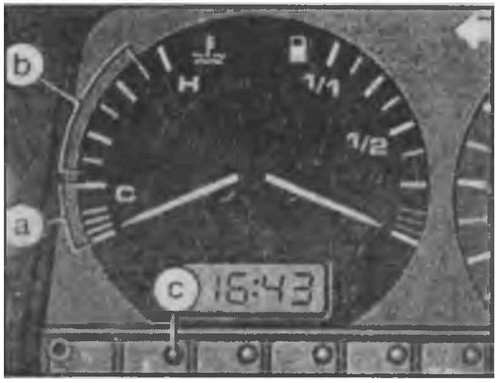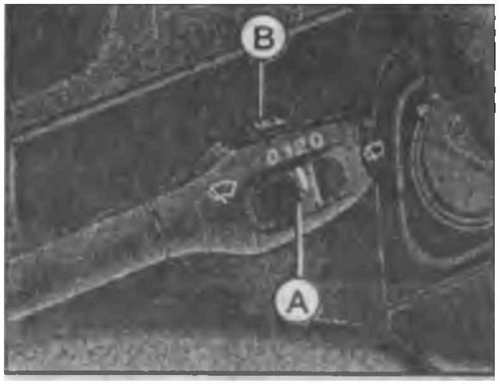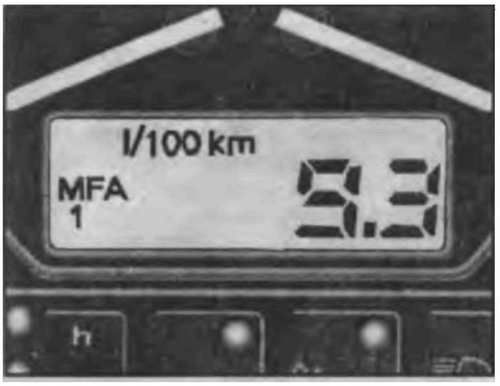Dashboard
The location of the instruments depends on the model of the Volkswagen Transporter T4 car and the type of engine (see Fig. 14).
Rice.
1.14 Instrument panel T4: 1 - speedometer, 2 - coolant temperature indicator, 3 - digital clock or on-board microprocessor display, 4 - fuel reserve indicator, 5 - tachometer or dial clock, 6 - automatic transmission mode display
Coolant temperature indicator (see 2, fig. 14)
Works only when the ignition is on.
When switched on, it blinks for a few seconds - the test lamp is being tested (c, Fig. 15).
With a heavy load on the engine and a high outside temperature, it is possible from time to time the pointer moves to the upper zone of the scale. This is not dangerous until the control lamp (c) starts flashing.
Rice.
15 Coolant temperature indication a - low temperature zone, c - operating temperature zone, c - control lamp.
If the control lamp starts flashing while driving, you need to see what temperature the indicator shows.
If the arrow is in the operating temperature zone, it is recommended to add coolant to the system. If the arrow is in the upper zone of the scale, then this means that the temperature of the coolant is too high. It is recommended to stop the car, turn off the engine and determine the cause of the increase in coolant temperature. Note.
Installing additional headlights in front of the radiator grill reduces the efficiency of the cooling system. If the ambient temperature is high and the engine is heavily loaded, there is a danger of overheating! Electronic clock with digital indication (see 3, fig. 14)
To set the exact time on the instrument panel of the Volkswagen Transporter T4, there are two buttons on the left under the instrument cluster.
Use the top button (H) to set the hour, and the bottom button (min) to set the minutes. Display of the on-board microprocessor
The display (multifunctional indicator MFA) of the T4 instrument panel, along with the indication of the current time, is designed to indicate the following additional information:
- travel time;
- average fuel consumption:
- distance traveled: average speed;
- engine oil temperature;
- outside air temperature. The microprocessor display indications are the same for all vehicles, but the layout of the keys is different for models with and without a rear wiper (see fig. 16 and 17).
Rice. 16 Control buttons - vehicles without rear window wiper
Rice. 17 Control buttons - vehicles with rear window wiper
The icon at the top of the display (see fig. 18) of the Transporter T4 panel shows which parameter is currently appearing, with the exception of the current time display.
Alternately displaying information on the display, starting from the current time, is carried out with the ignition on by repeatedly briefly pressing the button B located on the wiper stalk (see Fig. 16 and 17).
Rice. 18 On-board microprocessor display - specific fuel consumption mode
If the B key is kept pressed for more than 1 second, the next parameter on the display will be immediately replaced by the current time.
Blocks for collecting and storing information
The onboard microprocessor is equipped with two blocks for automatically collecting and storing statistical information.
The individual trip information storage unit (MFA1) collects and stores the following data from the moment the ignition is switched on until the moment it is switched off: driving time, distance traveled and the amount of fuel used.
Based on these data, the microprocessor calculates the average speed and average specific fuel consumption.
The trip is considered interrupted if the car has not been resumed for two hours since the ignition was turned off.
In the event of a break in the movement of the car for more than two hours, all data in the drive is automatically reset to zero. The cumulative vehicle mileage storage unit (MFA2) collects all data for any number of trips up to 100 hours of cumulative vehicle movement, or 10,000 km or 1,000 liters of fuel used (whichever comes first).
After reaching one of the specified values, the data in the memory is reset to zero. The collected information is used to calculate averages for all trips of specific fuel consumption and speed. To obtain the relevant information from the block, it is necessary to set the key (A) (see Fig. 16 and 17) on the wiper stalk:
position 1 - information block for individual trips
position 2 - information block for the group of recent trips.
The following data can be retrieved from the unit's memory:
- travel time;
- average specific fuel consumption;
- distance traveled;
- average speed.
Erasing data in drives
To reset data in each block individually, it is necessary to move the key (A) to position (0) with the ignition on and hold it in this position for more than one second.
When the battery is disconnected, the data contained in both drives is also reset to zero. Indications
When the ignition is switched on, the display shows "MFA 1" or "MFA 2" depending on which unit is selected.
No icon — indication of the current time
The indication of the current time remains even when the ignition is off.
Travel time
Switch position 1 shows the travel time that has elapsed since the ignition was switched on or the data in the MFA1 memory was cleared.
In switch position 2, the total time of all individual trips is displayed (memory of the MFA2 unit).
The maximum possible reading in both positions is 99 hours and 59 minutes.
Indication 1/100 km - average specific fuel consumption
The average value of specific fuel consumption is displayed on the instrument panel of the Volkswagen Transporter T4 (do not confuse with fuel consumption at the moment).
This indication appears on the display immediately after switching on the ignition or after a run of 100 m since the reset of the corresponding drive.
Prior to this, strokes appear on the display instead of numbers. While driving, the data is updated every 5 seconds. In position 1 on the display is the average specific fuel consumption for this trip (MFA1).
In position 2 on the display is the average specific fuel consumption for the last trips (MFA2).
Indication “km” - distance traveled
The process of obtaining information is similar to that described above.
The maximum value of the displayed mileage is 9999 km. Indication “km/h” – average driving speed
Engine oil temperature – ºС
Engine oil temperature is displayed in the range from +50ºС to +160ºС.
While strokes are displayed instead of numbers on the screen, the engine has not yet warmed up, and therefore it should not be heavily loaded. If the temperature reaches +145ºС. it is recommended to reduce the engine speed. Outdoor air temperature — ºС
Indication range from -40ºС to +50ºС.
After turning off the ignition, the last reading of the outside air temperature in the block on the instrument panel of the Volkswagen Transporter T4 is stored for approximately 45 minutes.
If the ignition is switched on after this time has elapsed, or if the vehicle has been driven for 45 minutes at a speed of at least 30 km/h before this time has elapsed, the display will show updated data. Fuel gauge (see 4, fig. 14)
Operates only when the ignition is on.
The fuel tank capacity is approximately 80 liters.
If the pointer has reached the zone of minimum fuel supply (three marks at the bottom of the scale), it means that there are about 10 liters of fuel left in the fuel tank.
Tachometer (see 5, fig. 14)
The tachometer needle must never enter the red zone of the scale.
The green zone on the tachometer scale indicates the crankshaft speed range corresponding to the optimal torque values, and therefore the most economical mode.
During the break-in period, it is recommended to avoid running the engine at a high crankshaft speed.




